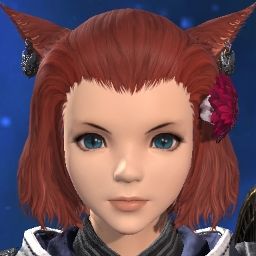I'm going to keep my contributions here rather thin since this one's murf's deal and he's totally got this, but to make a few things clear:
Yes, the main moon is named Menphina, regardless of how often they call it Menphina. I do know they've referred to it as the physical manifestation of this deity, but I've never heard them say, "Mm, yes. Full Menphina tonight. Be careful. Menphinatics out there."
Yes, Eorzea seems to be in the Northern Hemisphere. Remember, this game is based on Greece. You can see in the screenshot above that it's right about where Europe would be on the sphere, and the consciousness of the planet has become the mothercrystal seemingly right under these lands.There are some who would have us believe that Menphina and Dalamud are just rocks, the latter in orbit around the former, but such talk is outright sacrilege!
EDIT: Link removed due to screenshot above.
Thread: Constellations and the Night Sky
-
03-21-2013 06:52 AM #11Player

- Join Date
- Mar 2011
- Location
- Limsa Lominsa
- Posts
- 5,043
- Character
- Anony Moose
- World
- Excalibur
- Main Class
- Arcanist Lv 100
(4)Last edited by Anonymoose; 03-21-2013 at 07:16 AM.
"I shall refrain from making any further wild claims until such time as I have evidence."
– Y'shtola
-
03-21-2013 07:08 AM #12Player

- Join Date
- Dec 2012
- Location
- Ala Mhigo
- Posts
- 8,340
- Character
- Enkidoh Roux
- World
- Balmung
- Main Class
- Paladin Lv 90
That link isn't working sadly. ; ;
But you make a good point about the moon's name - returning to my earlier point about the real moon, how many people actually know that in astronomy, Earth's moon is officially called 'Luna'? Not many I'd imagine. Because in nearly all cases it's just simply referred to as 'the moon'. It's easier to say as it's a shared term that can translate easily into all languages, rather than having to deal with converting what is an ancient Latin name into languages where the context might be lost.
So I do believe you might have hit the nail on the head about Menphina - I can definitely imagine most Eozeans just calling it the 'primary moon' or even just 'THE moon' (after all, before Nael pulled it out of whack Dalamud was so tiny in the night sky it seemed more like just another star than a moon).
-
03-21-2013 07:20 AM #13Player

- Join Date
- Mar 2011
- Location
- FL,Hialeah
- Posts
- 5,526
- Character
- Zenaku Yamada
- World
- Cactuar
- Main Class
- Conjurer Lv 50
If you look at FFXIV night sky there stars in the color of each element just like ffxi. So i'm guessing there is constellation maybe one of the new race come from other world for all we know
 (1)Tactics Ogre: Let Us Cling Together Autographed By "Akihiko Yoshida Tarot Card Sweepstakes Winner
(1)Tactics Ogre: Let Us Cling Together Autographed By "Akihiko Yoshida Tarot Card Sweepstakes Winner

-
03-21-2013 07:51 AM #14Player

- Join Date
- Oct 2012
- Posts
- 493
- Character
- Myranda Al'cyoene
- World
- Hyperion
- Main Class
- Conjurer Lv 80
Strictly and scientifically speaking (as determined by the International Astronomical Union which is in charge of regulating the naming of celestial bodies), its English name is "the Moon" (note the capitalization and inclusion of "the" in the quotes), and the same goes for "the Sun". Luna (and Sol) are the Latin names for them, but the official modern names are just the Moon and the Sun. The Latin versions are almost exclusively used in fiction to invoke a sense of "scienciness" or advanced civilization, or in poetry just to be... poetic... but nobody uses them in the scientific community and literature, just like no scientist seriously references Earth as Gaia or Terra. Other languages may use something closer to the Latin (like Spanish la luna), but in those languages it doesn't sound foreign or special, it's just the way they happen to say "the Moon" in the same way our Spaniard might call a dog a perro. When it comes to Menphina I do however concur that very few citizens would refer to it by name, and just simply say "the moon" as suggested.
(Fun fact: professional astronomers don't call our galaxy the Milky Way in journals either, it's just "the Galaxy")
As far as our attempts to determining the latitude of Eorzea on Hydælyn, drawing conclusions based on that screencap do of course depend on our European cultural notion of north as being "up": our Australian friends may want to have a word with us... Of course, with the developers being Japanese, it's again not a far stretch to assume this is the convention being used, especially given the orientation of the in-game compass, no matter how much calling south "up" would be just as valid a viewpoint.
(For the record, I don't think we can actually glean with any confidence anything about the axial tilt of Hydælyn's rotation relative to its orbit based on current evidence, including the light bloom. The planet isn't shown to rotate in the trailer so it could just be camera perspective. Hell, we could attribute the apparent lack of in-game seasonal weather effects as evidence of a 0° tilt, though we run into problems with frozen-time paradoxes as once explained by Ferne in relation to main story events needing to be pegged down to a given year, regardless of when a particular player completes the content.)
This ended up way longer and more nuanced than I originally intended... but that's what I studied in grad school, so... @.@(5)Last edited by Myranda; 03-21-2013 at 09:06 AM.
Check out my Eorzean fonts! - Twitter: @MyrandaFFXIV
http://dachoutom.no-ip.org/ffxiv/fonts.html
The Astronomical Society of Eorzea!
http://forum.square-enix.com/ffxiv/threads/142965-The-Astronomical-Society-of-Eorzea
-
03-21-2013 09:42 AM #15Player

- Join Date
- Oct 2011
- Location
- Limsa Lominsa
- Posts
- 1,235
- Character
- Y'ruh Tia
- World
- Sargatanas
- Main Class
- Botanist Lv 99
Reminds me of my expectations for Dalamud:
A.) Dalamud contains a dungeon where we fight to destroy it from the inside.
B.) Dalamud contains monsters that will run rampant in 2.0
C.) Dalamud is a mini-Death Star, and can shoot lasers at the planet
I guess B is the more correct answer, but C was correct during the Van Darnus fight.
-
03-21-2013 09:53 AM #16Player

- Join Date
- Mar 2011
- Location
- Gridania
- Posts
- 17
- Character
- Kenmei Aquila
- World
- Sargatanas
- Main Class
- Thaumaturge Lv 90
I have to disagree here, there was definitely a cloudy galactic streak in Eorzea's sky in 1.0, I even have a couple screenshots to show it.

http://img833.imageshack.us/img833/7...1312672180.jpg
http://img823.imageshack.us/img823/6...1307724287.jpg
On the subject of Eorzea's position in the northern hemisphere, we have some more evidence of this in the way the sun and moon moved in Eorzea's sky. I spent some time stargazing in 1.0 and noticed that the sun and moon move in a southerly arc (suggesting that we are in the northern hemisphere) rather than passing through the zenith (which would suggest we are near the equator) or moving in a northerly arc (which would suggest we are in the southern hemishpere).
Back on topic though, I love all the suggestions for ARR's sky made here. I'm glad I wasn't the only one to notice all the inconsistencies with 1.0's moon phases and how it waxed/waned. (7)
(7)
-
03-21-2013 10:05 AM #17Player

- Join Date
- Oct 2012
- Posts
- 493
- Character
- Myranda Al'cyoene
- World
- Hyperion
- Main Class
- Conjurer Lv 80
Excellent points there, sir!
So we can firmly establish that Hydælyn is located in a flattened galaxy and that Eorzea is in the northern hemisphere. That leaves us with the uncomfortable choice then that Menphina orbits retrograde compared to Hydælyn's rotation which is physically unlikely, or that the phases are mismatched and go in the reverse order that they should be.
So yeah, how about them constellations???
Wonder if Ferne is regretting the creation of the lore forum yet, lol... soon as it opened we've been flooding the thing with little minutiae that we've been holding back from posting off-topic in the Loc forums. Either that or he and the Loremasters are relishing the fact we care so much about their world.(8)Check out my Eorzean fonts! - Twitter: @MyrandaFFXIV
http://dachoutom.no-ip.org/ffxiv/fonts.html
The Astronomical Society of Eorzea!
http://forum.square-enix.com/ffxiv/threads/142965-The-Astronomical-Society-of-Eorzea
-
03-21-2013 10:18 AM #18Player

- Join Date
- Mar 2011
- Location
- Limsa Lominsa
- Posts
- 5,043
- Character
- Anony Moose
- World
- Excalibur
- Main Class
- Arcanist Lv 100
Being in a linkshell (soon-to-be company) that has a steady subcommunity of Mumble users, I've had the pleasure of hearing murf rant about this one at length, which can get hysterical. Companies that like to world-build simply don't often have realistic celestial bodies. I wonder how hard it would be to fix the moon program...
Probably a little bit of each, lol.
The two major points of the lore forum are met, however. We have a place to talk about this stuff and the Localization forum is now free of grammatically correct ambiguities. What vagueries they intend to clarify for us is up to them - but I'm sure anything the community at large is interested enough in to keep a thread going will at least get a nod someday.
That said, it's been a quiet week. The LOC squad is probably drowning in beta phase two Grand Company content and phase three city preparation.(4)"I shall refrain from making any further wild claims until such time as I have evidence."
– Y'shtola
-
03-21-2013 10:21 AM #19Player

- Join Date
- Mar 2011
- Location
- Gridania
- Posts
- 51
- Character
- Aqualin Riversong
- World
- Excalibur
- Main Class
- Conjurer Lv 80
Would it not be possible to gleam a rough latitude by locating the celestial pole (either north or south, and assuming it properly exists), and finding how many degrees it sits off the horizon? [Again, I'm an amateur, so I'm not 100% sure how it works.]
That was more me not remembering than anything. I'm glad to see something was there at least, and I hope it makes it into ARR.
Of course, there are all manner of things we could note are missing due to improper orbital motions: Seasons, time zones, adjustments to the celestial sphere based where your current location is, effects of light pollution when in cities, etc. I don't want to complain too much, and seeing it is a fantasy world, there is some amount that I can forgive, but others (like moon phases in the wrong part of the sky) that a little more research could do well to improve the immersion. But it is a lot of work for little payoff, so I can understand why it may not be on the critical list.(4)
-
03-21-2013 10:46 AM #20Player

- Join Date
- Oct 2012
- Posts
- 493
- Character
- Myranda Al'cyoene
- World
- Hyperion
- Main Class
- Conjurer Lv 80
Yes, this would be one method (altitude of pole = latitude), and as it turns out is equivalent to Kenmei's statement about the arc of the Sun's daily path. Both are direct consequences of latitude causing the rotational axis to tilt with respect to the local horizon, regardless of how the axis is tilted to the orbital plane. So we really can unequivocally say Eorzea is in the northern hemisphere, no doubt at all.
Man, I wish I got to know you guys more during 1.0, our lore-hungry Excalibur server... My own LS/FC is yet to decide on what we'll do for 2.0 server since that information hasn't been released to us, but if we end up on the same server still I might have to hit you guys up for the /flist, or maybe get a pearl if your FC will be operating an LS arm as well (I will of course, be loyal to my current LS for joining a FC, considering I'm now an officer for it).
Back on topic and responding to both of you, I definitely also don't expect every last detail to be accurate in any game's night sky. It's just not feasible from a programming standpoint for very little return on investment, as we all recognize. The moon phases thing should be fairly easy to deal with though, it's basically just sliding one texture over another, how hard can that be?(4)Check out my Eorzean fonts! - Twitter: @MyrandaFFXIV
http://dachoutom.no-ip.org/ffxiv/fonts.html
The Astronomical Society of Eorzea!
http://forum.square-enix.com/ffxiv/threads/142965-The-Astronomical-Society-of-Eorzea



 Reply With Quote
Reply With Quote










